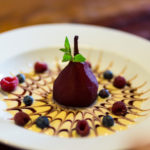PORCHETTA-STYLE RABBIT, THE GENIUS FROM MARCHE

Porchetta is a typical dish of Central and Northern Italy. It consists of a whole pig, emptied, deboned and seasoned with rosemary or wild fennel, according to its origin.
According to the traditional way of making it, porchetta is seasoned with rosemary in Southern Tuscany, in Roman Castles area and other areas in Central Italy; in Northern Lazio, Umbria, Marche, and Romagna they prefer to season it with wild fennel, which gives it smell and taste absolutely unique.
Like the word parmigiana, in porchetta describes also the cooking and seasoning style for other meats, like the rabbit, in this case.
I bought a farmyard rabbit, for this dish. This was a summer dish since in August and September rabbits who were born in the springtime had reached the right weight. Nowadays, industrial agriculture has altered these natural cycles.
I have never tasted the famous porchetta in Ariccia, near Rome, which is seasoned with rosemary.
In Ravenna market, my family has always been buying porchetta from Marche, made by a gentle lady who prepares this fantastic product, together with ciccioli and lard, two products which are used so widely in our family piadine and focacce. The presence of the wold fennel, added with a gentle touch, gives an unmistakable note.
Prep Time: 10 minutes | Cooking Time: 1 h + 30 minutes | Total Time: 1 hour and 40 minutes | Yield: Makes 4 servings.
Ingredients
- 3 ½ pounds (1,5 kg.) rabbit, with its liver
- 1/2 cup roughly chopped wild fennel fronds, or a 12-inches branch of wild fennel, in chunks. If you cannot find it, replace with 1 tablespoon fennel seeds
- 4 oz. (100 g.) pancetta, roughly chopped
- 2 oz. (50 g.) lard, roughly chopped
- 6 garlic cloves
- 3 tablespoons extra-virgin olive oil
- 2 glasses white dry wine
- Salt and black pepper for seasoning
Instructions
Wash rabbit and liver with the wine. Season the rabbit (inside too) with salt and pepper.
Roughly chop liver, and sauté it in a pan with pancetta, 1 olive oil, 3 garlic cloves and 2/3 fennel, season with salt and pepper. Stuff the rabbit with it and sew it with needle and thread, in order to avoid the rabbit to lose the stuffing while cooking. Transfer the rabbit to a roasting pan with lard, 3 garlic cloves, oil, fennel, and bake for 1 1/2 hours at 350 F (180 C).





